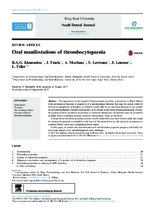| dc.contributor.author | Lawrence, Stephen | |
| dc.contributor.author | Khammissa, R.A.G. | |
| dc.contributor.author | Fourie, J. | |
| dc.contributor.author | Masilana, A. | |
| dc.contributor.author | Lemmer, J. | |
| dc.contributor.author | Feller, L. | |
| dc.date.accessioned | 2019-08-12T13:57:17Z | |
| dc.date.available | 2019-08-12T13:57:17Z | |
| dc.date.issued | 2018 | |
| dc.identifier.citation | Khammissa, R., Fourie, J., Masilana, A., Lawrence, S., Lemmer, J., & Feller, L. (2018). Oral manifestations of thrombocytopaenia. The Saudi Dental Journal, 30(1), 19-25. doi:10.1016/j.sdentj.2017.08.004 | en_US |
| dc.identifier.issn | 1013-9052 | |
| dc.identifier.uri | https://doi.org/10.1016/j.sdentj.2017.08.004 | |
| dc.identifier.uri | http://hdl.handle.net/10566/4774 | |
| dc.description.abstract | The appearance in the mouth of haemorrhagic petechiae, ecchymoses or blood blisters
with spontaneous bleeding is suggestive of a haemorrhagic disorder that may be caused either by
functional impairment of platelets or of blood vessel walls, by an abnormal decrease in the number
of circulating platelets (thrombocytopaenia), or by defects in the blood clotting mechanism. Thrombocytopaenia
from decreased production or increased destruction of platelets may be caused by
multiple factors including immune mediated mechanisms, drugs or infections.
A diagnosis of thrombocytopaenic purpura can be made when any other disease entity that might
be causing the purpura is excluded on the basis of the medical history, the physical examination, a
complete blood count and a peripheral blood smear.
In this paper, we outline the clinical features of oral thrombocytopaenic purpura and briefly discuss
some aspects of its aetiopathogenesis and treatment. | en_US |
| dc.language.iso | en | en_US |
| dc.publisher | Elsevier | en_US |
| dc.subject | Ecchymosis | en_US |
| dc.subject | Petechiae | en_US |
| dc.subject | Haemorrhagic blister | en_US |
| dc.subject | Immune mediated thrombocytopaenia | en_US |
| dc.title | Oral manifestations of thrombocytopaenia | en_US |
| dc.type | Article | en_US |

